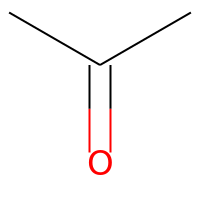
Acetone
| Predicted Absorption properties | |||
|---|---|---|---|
| Property | Tool | Interpretation | Probability/Value |
| Caco-2 permeability | admetSAR | No | - |
| pkCSM | High | 1.489 cm/s | |
| Human Intestinal Absorption | admetSAR | Yes | - |
| pkCSM | High | 100 % | |
| SwissADME | High | - | |
| Human Oral Bioavailability | admetSAR | No | - |
| Log Kp (Skin permeation) | pkCSM | High | -2.796 cm/h |
| SwissADME | - | -6.69 cm/s | |
| Predicted Distribution properties | |||
|---|---|---|---|
| Property | Tool | Interpretation | Probability/Value |
| P-glycoprotein substrate | admetSAR | No | - |
| pkCSM | Yes | - | |
| SwissADME | No | - | |
| vNN | No Prediction | - | |
| P-glycoprotein inhibitor | admetSAR | No | - |
| vNN | No Prediction | - | |
| P-glycoprotein inhibitor I | pkCSM | No | - |
| P-glycoprotein inhibitor II | pkCSM | No | - |
| Blood Brain Barrier | admetSAR | Yes | - |
| pkCSM | Moderate | -0.016 logBB | |
| SwissADME | No | - | |
| vNN | No Prediction | - | |
| CNS permeability | pkCSM | Moderate | -2.484 logPS |
| Fraction unbound in human | pkCSM | - | 0.751 |
| Plasma protein binding | admetSAR | 100% | -0.279 |
| Subcellular localization | admetSAR | Mitochondria | - |
| Steady state volume of distribution (VDss) | pkCSM | Moderate | -0.135 L/Kg |
| Predicted Metabolism properties | |||
|---|---|---|---|
| Property | Tool | Interpretation | Probability/Value |
| CYP1A2 inhibitor | admetSAR | No | |
| pkCSM | No | - | |
| SwissADME | No | - | |
| vNN | No | - | |
| CYP2C19 inhibitor | admetSAR | No | - |
| pkCSM | No | - | |
| SwissADME | No | - | |
| vNN | No | - | |
| CYP2C9 inhibitor | admetSAR | No | - |
| pkCSM | No | - | |
| SwissADME | No | - | |
| vNN | No | - | |
| CYP2C9 substrate | admetSAR | No | - |
| CYP2D6 inhibitor | admetSAR | No | - |
| pkCSM | No | - | |
| SwissADME | No | - | |
| vNN | No | - | |
| CYP2D6 substrate | admetSAR | No | - |
| pkCSM | No | - | |
| CYP3A4 inhibitor | admetSAR | No | - |
| pkCSM | No | - | |
| SwissADME | No | - | |
| vNN | No | - | |
| CYP3A4 substrate | admetSAR | No | - |
| pkCSM | No | - | |
| CYP inhibitory promiscuity | admetSAR | No | - |
| Human Liver Microsomal (HLM) stability assay | vNN | No Prediction | - |
| OATP2B1 inhibitor | admetSAR | No | - |
| OATP1B1 inhibitor | admetSAR | Yes | - |
| OATP1B3 inhibitor | admetSAR | Yes | - |
| MATE1 inhibitor | admetSAR | 0.98 | - |
| BSEP inhibitor | admetSAR | No | - |
| UGT catalysis | admetSAR | No | - |
| Predicted Excretion properties | |||
|---|---|---|---|
| Property | Tool | Interpretation | Probability/Value |
| Renal OCT2 inhibitor | admetSAR | No | - |
| Renal OCT2 substrate | pkCSM | No | - |
| Total clearance | pkCSM | - | 0.637 ml/min/kg |
| Predicted Toxicity properties | ||||
|---|---|---|---|---|
| Property | Tool | Interpretation | Probability/Value | |
| Acute oral toxicity | admetSAR | - | 1.102 kg/mol | |
| Acute oral toxicity class | admetSAR | III | - | |
| Biodegradation | admetSAR | Yes | - | |
| Toxtree | Class 2 (persistent chemical) | - | ||
| Carcinogenicity (Three class) | admetSAR | Non-required | - | |
| Carcinogens | admetSAR | No | - | |
| Toxtree | No | - | ||
| Cramer's rule | Toxtree | Low (Class I) | - | |
| Cytotoxicity | vNN | No Prediction | - | |
| Genotoxic carcinogenity | Toxtree | No | - | |
| Hepatotoxicity | admetSAR | No | - | |
| pkCSM | No | - | ||
| vNN | Yes | - | ||
| Human Ether-a-go-go-Related Gene Inhibitor | admetSAR | No | ||
| vNN | No | - | ||
| Human Ether-a-go-go-Related Gene Inhibitor I | pkCSM | No | - | |
| Human Ether-a-go-go-Related Gene Inhibitor II | pkCSM | No | - | |
| Mitochondrial Membrane Potential (MMP) | vNN | No | - | |
| Maximum Recommended Tolerated Dose (MRTD) | pkCSM | High | 1.2 mg/kg/day | |
| vNN | - | 958 mg/day | ||
| Non-Genotoxic carcinogenicity | Toxtree | No | - | |
| Oral rat acute toxicity | pkCSM | - | 2.03 mol/kg (LD50) | |
| pkCSM | - | 1.675 mg/kg_bw/day (LOAEL) | ||
| Micronucleus | admetSAR | No | - | |
| Skin sensitisation | pkCSM | No | - | |